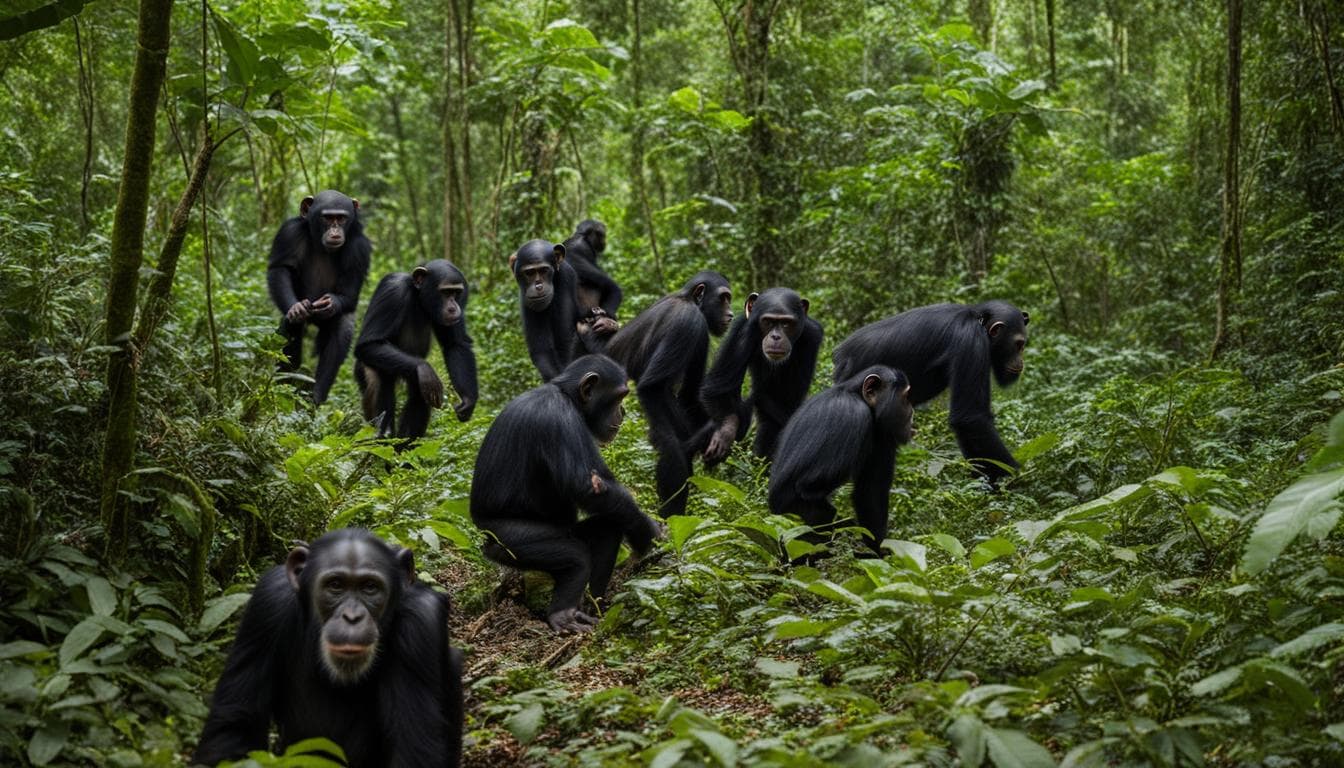Researchers utilize various techniques to study and track wild chimpanzee populations, which involve monitoring their behavior, tracking their movements, and assessing population sizes to understand their dynamics. Field research and the use of advanced technology play crucial roles in collecting data on chimpanzee populations.
In addition to tracking devices, researchers collect data on chimpanzee habitat use(collecting data on chimpanzee habitat use). By studying the locations where chimpanzees spend their time, researchers can determine their preferred habitats and identify areas that are critical for their survival. This information is invaluable for conservation planners and policymakers, as it helps them make informed decisions about habitat protection and management.(monitoring chimpanzee range)
Through GPS tracking devices and other data collection methods, researchers can paint a comprehensive picture of chimpanzee behavior and movement patterns. This knowledge lays the foundation for effective conservation strategies and ensures the long-term survival of these incredible creatures.
Assessing Chimpanzee Population Sizes
To accurately assess chimpanzee population sizes, researchers employ various methods that combine field observations, genetic analysis, and habitat surveys. These techniques provide valuable insights into the estimated number of chimpanzees in a particular area and help inform conservation efforts.
Population Sampling Methods
One common approach involves population sampling, where researchers collect data from a representative subset of the chimpanzee population to estimate the total count. This method relies on statistical analysis to extrapolate population size based on the observed sample. By carefully selecting study sites and employing rigorous data collection protocols, scientists can derive meaningful population estimates.
Analyzing Genetic Data
Another technique used to assess chimpanzee populations is genetic analysis. Researchers collect DNA samples from individuals in the target population and analyze their genetic diversity. This information allows for the estimation of population size, genetic structure, and the presence of distinct subpopulations. Genetic analysis provides critical insights into the health and genetic viability of chimpanzee populations.
Counting Chimpanzee Nests
Counting chimpanzee nests in the wild is another method employed to estimate population densities. These nests are constructed by chimpanzees for sleeping and resting, and their abundance indicates the presence and activity level of chimpanzee communities. Researchers survey specific areas to count and classify the nests, providing valuable data on population distribution and density in different habitats.
Studying Wild Chimpanzee Behavior
Studying the behavior of wild chimpanzees involves detailed observations of their social interactions, tool use, vocalizations, and feeding behavior. Researchers meticulously document these behaviors to gain insights into the social dynamics, communication patterns, and adaptability of chimpanzees in their natural environment.
By closely observing their social interactions, researchers can unravel the intricate web of relationships within chimpanzee groups. They study the formation of alliances, hierarchy, and cooperation among individuals, shedding light on the complexities of chimpanzee societies.
Tool use is another intriguing aspect of chimpanzee behavior that researchers focus on. Chimpanzees have been observed using tools for various purposes, such as foraging, grooming, and even hunting. These observations help us understand the cognitive abilities and problem-solving skills of these intelligent primates.
Vocalizations play a crucial role in chimpanzee communication. Researchers analyze different vocalizations, including screams, pant hoots, and grunts, to decipher their meanings and functions. These vocalizations convey important information related to social status, group cohesion, and territorial boundaries.
Feeding behavior is also a significant area of study in understanding wild chimpanzees. Researchers observe the types of food chimpanzees consume, their foraging strategies, and the sharing of food within the group. This provides insights into their dietary preferences, nutritional needs, and adaptations to the environment.
Technological Advancements in Chimpanzee Population Monitoring
Technological advancements have revolutionized the way researchers monitor chimpanzee populations, providing valuable insights into their behavior and aiding conservation efforts. One notable advancement is the development of AI software for chimpanzee recognition. This innovative software can accurately identify and track individual chimpanzees in video footage, even in challenging conditions.
Through advanced video analysis, researchers can now monitor chimpanzee behavior over extended periods of time. This long-term monitoring allows for a deeper understanding of social dynamics, feeding patterns, and migration behaviors within chimpanzee populations. The data collected through these technological advancements contributes to our knowledge of chimpanzees, not only in their natural habitats but also in response to environmental changes.
The application of these technological advancements in chimpanzee population monitoring goes beyond research purposes. Conservation organizations can utilize this data to develop effective strategies for protecting chimpanzee populations and their habitats. By understanding the behavioral patterns and population dynamics of chimpanzees, conservation efforts can be tailored to address specific conservation priorities and ensure the long-term survival of these remarkable animals.
How does studying and tracking wild chimpanzee populations help researchers understand their lifespan in the wild?
Studying and tracking wild chimpanzee populations provide valuable insights into the average lifespan of chimpanzees in the wild. By observing behaviors, reproductive patterns, and environmental factors, researchers can better understand the factors that contribute to the average lifespan of chimpanzee and how they vary across different habitats.
What methods do researchers use to study and track wild primate populations in their natural habitats?
Researchers studying wild gorilla populations typically use a combination of methods such as direct observation, camera traps, and genetic sampling. Direct observation involves physically tracking and recording gorilla behavior. Camera traps capture images and footage, while genetic sampling helps identify individual gorillas and assess population size and structure.







